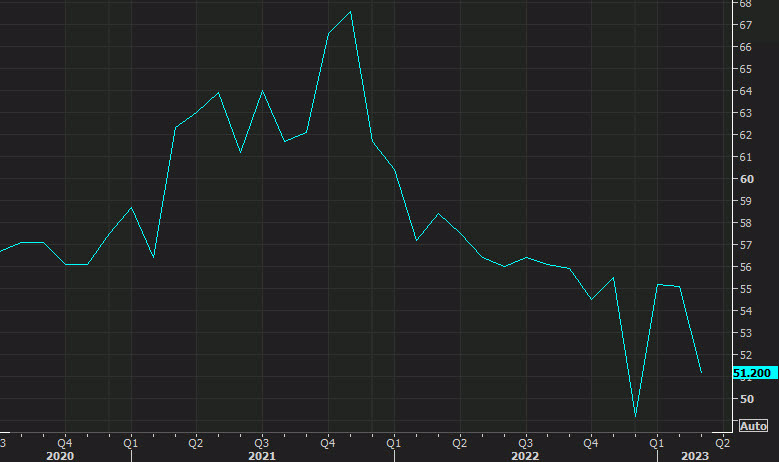
- Prior was 55.1
- employment index 51.3 versus 54.0 prior
- new orders index 52.2 versus 62.6 expected
- prices paid index 59.5 versus 65.6 prior
- new export orders 43.7 versus 61.7 last month
- imports 43.6versus 52.6 last month
- backlog of orders 48.5 versus 52.8 last month
- inventories 52.8 versus 50.6 last month
- supplier deliveries 45.8 versus 47.6 last month
- inventory sentiment 57.9 versus 55.3 last month
That drop in new orders is a sharp one and overall this looks like a survey that's recoiling from a bank crisis. Now the question is: Does it recover quickly from the banking rout? Or is there a lasting change in market/consumer psychology? We won't know until next month but at least the lower inflation number will give the Fed some comfort.
Note that we also saw a drop in this survey in January, only for it to quickly rebound. That's unusual for this survey, which is usually a great forward-looking barometer.
Comments in the report:
- “Restaurant sales remain favorable compared to pre-pandemic trends. Traffic is recovering and nearly flat. We are optimistic about the coming months and have invested in building remodeling and equipment, as well as a new back office and POS (point of sale) system.” [Accommodation & Food Services]
- “Sales continue to increase even as interest rates moderately increase. Most suppliers feel their supply chains are back to normal, with inventories climbing and delivery times improving. (We) fear this will have a detrimental effect in a six- to 12-month time frame.” [Construction]
- “Still experiencing shortages in general labor positions amid demand for higher entry-level wages.” [Educational Services]
- “Close of first quarter business conditions are steady. Already projecting out for 2024. Economic uncertainty is still a concern, and interest rates are continuing to be monitored closely.” [Finance & Insurance]
- “Although patient volumes and revenues continue to be strong, labor and inflationary pressures have led to higher operating expenses, exceeding revenues and resulting in negative operating margins. Supply chains issues are easing, leading to fewer stockouts, though inventory levels are not as healthy as preferred. Enjoying continuous improvement in (lead times), labor, price stability and product reliability. The near-term forecast is optimistic.” [Health Care & Social Assistance]
- “Slowdown in the economy is leading to reduced expenditure amounts.” [Information]
- “Our company continues to have a cautious approach to the future. Continuing uncertainty regarding inflation and oil and gas regulations.” [Management of Companies & Support Services]
- “There continues to be uncertainty in the market regarding future investments. Interest rate hikes seem to have done little to slow down consumer spending. The likelihood of a mild slowdown in the second half of 2023 or 2024 is still pretty high. Layoffs will continue.” [Professional, Scientific & Technical Services]
- “Increased stability in logistics and transportation services have helped stabilize the flow of goods and materials.” [Public Administration]
- “Diesel fuel (prices) down 16 percent and unleaded down 9 percent from a month ago. Other than composite materials, most materials are readily available. Sales have dipped only slightly during this above-normal rainy season and are still consistent with normal winter sales.” [Utilities]
- “Supply is starting to stabilize. Prices are coming down but in small increments. Food prices remain high, and availability continues to be a challenge.” [Transportation & Warehousing]



